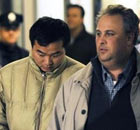-
-
China Daily E-paper
Liang Hongfu
Can we give this city a proper image
By Hong Liang (China Daily)
Updated: 2010-01-15 06:42
 |
Large Medium Small |
A banker friend of mine in Hong Kong has visited Shanghai many times, mostly for business. But she still couldn't see what's there to like about the city, which, to her, is just like any other cosmopolitan sprawl that is distinguished only by the number of luxury hotels, fancy restaurants and Starbuck's cafes.
She e-mailed me last week to say she was coming to Shanghai for yet another business meeting which crosses a weekend, and asked me how best could she spend the two-day free time in the city by herself. That should be easy, except that her condition was to have an experience that would make her fall in love with the city.
I am not sure if this is possible. Decades of unbridled development with scant respect to aesthetics has erased much of the original charm of Shanghai. As my friend has observed, Shanghai is no more than an upstart among such global metropolises as New York, London and Paris.
That, of course, is not entirely true. Like most business travelers to Shanghai, my friend seldom has the time to venture out to explore the city. They are not necessarily aware of the municipal government's efforts in recent years to create new landmarks to recapture the romance of old Shanghai and salvage some historical sites and buildings associated with people and events that are locked in the fond memories of many older generation Shanghai natives.
Last month, I saw on local TV a multi-part documentary on the rehabilitation of Suzhou Creek, a tributary that runs through the city into the Huangpu River at the Bund. In terms of cinematic technique, the documentary failed to excite. But I found the content most fascinating.
In the colonial days of the early 20th century, when Shanghai played host to some of Asia's largest industrial enterprises, banks and trading houses, hundreds of thousands of migrant workers from around the country worked at the many docks and warehouses along Suzhou Creek. There is no shortage of fabled stories of these penniless laborers rising to the ranks of merchant princes and property barons. But, of course, many more were destined to lead an ordinary life, raise their families and pass onto future generations the tradition of hard work and propriety.
In one segment of the documentary, the reporter interviews a woman who has been living in an old home near the creek. Although all her children and grandchildren have moved out, she says she prefers to stay there because all her friends are in the neighborhood. She loves Shanghai, although it is not the same city we see today.
There is not much to like about Shanghai as it is now. But the municipal government has taken what is seen to be a rather laid-back attitude in promoting the city overseas. In contrast, the Hong Kong government has done what is widely considered a highly professional job in projecting the city's dynamic image around the world.
While in Shanghai, I often come across television advertisements by other cities, including Seoul and Singapore, showing off their multi-faceted attractions to impress and entice potential Shanghai tourists. In other cities, I don't recall seeing anything like that from Shanghai.
I don't know Shanghai well enough to be of much help to my banker friend in her quest. But I am sure that many Shanghai people have the answer. Perhaps the government should collect the ideas of its people to devise a promotional scheme that will do justice to this city.
E-mail: jamesleung@chinadaily.com.cn









